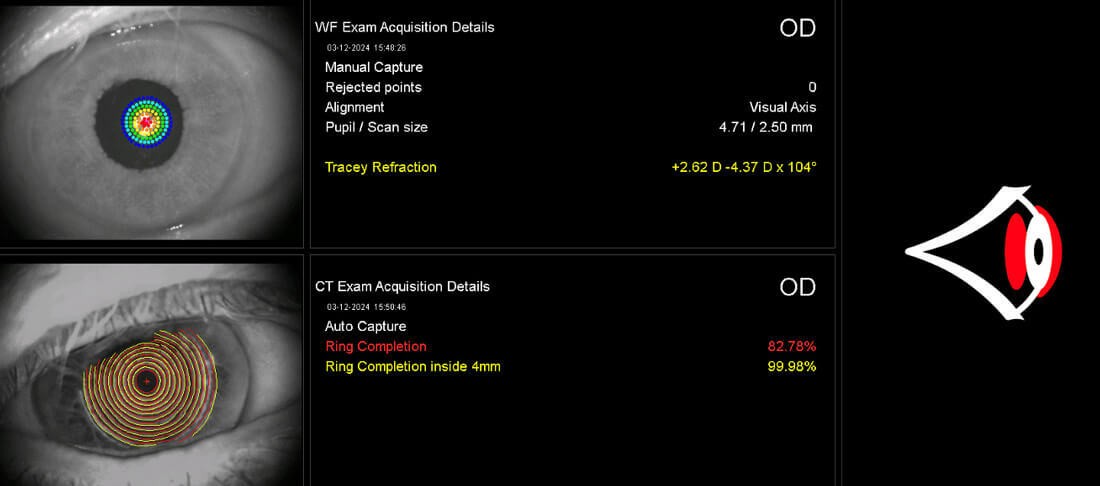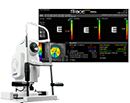Case Presentation: How iTrace Prime’s Dry Eye Assessment Makes Cataract Surgery Workup More Efficient
MEET Michael A. Farbowitz, MD
Dr. Michael Farbowitz is the owner of Short Hills, Ophthalmology, a two-location practice in New Jersey, where he emphasizes premium cataract surgery and dry eye diagnostics and treatment.
With the addition of Tear Film Analysis to a platform that supports surgeons’ ability to educate patients about their options, perform pre-surgical measurements, select the optimal IOL, and provide the best possible outcomes, the iTrace Prime software makes it the perfect tool for Dr. Farbowitz’s practice.
Dr. Farbowitz spoke at our user meeting at ASCRS 2024. Here’s a case he presented that demonstrates one way iTrace (specifically iTrace Prime) adds value to the pre-operative workflow.
- 63% had TFBUT lesser or equal to 5 seconds
- 77% had some staining
- 60% are asymptomatic
This presents a problem: If the tear film isn’t as stable as possible, it affects the quality of vision outcomes from cataract surgery.
Dr. Farbowitz’s Pre-Op Workup Before iTrace 7
Dr. Farbowitz brought up the challenges he experienced with his pre-surgical workflow before he upgraded to iTrace Prime featuring Tear Film Analysis. It’s impractical to test every cataract patient for dry eye in the initial evaluation, but when dry eye is discovered later on, it can delay the surgery until the ocular surface is more stable.
The options here all come with a degree of risk:
- The surgery is delayed and patients are disappointed and frustrated by the inconvenience
- The surgeon elects to play it safe and select a non-premium IOL, which limits the visual outcomes they’re able to produce
- The surgeon gambles and implants the premium lens anyway, which can lead to negative outcomes for post-op vision that don’t match the patients’ expectations
Dr. Farbowitz said, to avoid these pitfalls, he added additional touchpoints with the patient before surgery — which comes with its own pros and cons:
- More time for the patient to rehab the ocular surface
- More time for the patient to consider their IOL options
- Longer lead-up time before surgery — patients may seek another provider who will do the surgery sooner
- An extra visit can be difficult for the patient (transportation, distance, convenience)
- It can be inefficient for the practice to add appointments (techs spend more time with the patient without being able to bill for additional services
The New Workflow with iTrace 7
With the iTrace Prime software, the standard pre-op iTrace scan includes an assessment of the quality of the ocular surface using a new tool called the Tear Film Index (TFI). The TFI uses corneal topography to analyze the tear film breakup and produce an objective marker of tear film quality.
This allows the surgeon to see when it’s necessary to slow down in the workup to get the best outcomes, and when it’s safe to proceed to surgery without the other checkpoints.
He demonstrated the value of the new iTrace Exam Results Display using a case in his practice:

This is the first scan done at the initial evaluation. The icon on the right shows the cornea/anterior surface as red — meaning the ocular surface is not stable and will almost certainly affect the results of surgery if it’s performed without additional intervention and prompting his staff to conduct the tear film analysis exam.

The Tear Film Analysis Display confirms this data — the patient scores a 1.3 out of 10 on the objective TFI assessment. In order to get quality results with a premium IOL, the tear surface needs to be more stable.
In this case, Dr. Farbowitz used the iTrace displays to educate the patient on the current status, allowing them to understand the need to delay surgery for dry eye treatment.
This patient underwent a treatment program and came back for their final pre-op scan in much better shape.

Dr. Farbowitz was then able to perform a premium cataract surgery on this patient, allowing them to achieve visual outcomes that better matched their expectations, improving their satisfaction and his reputation as a provider.
Essentially, iTrace 7 gives Dr. Farbowitz data that allows him to eliminate the guesswork and customize the pre-op process to the specific case, improving two key aspects of his practice:
- Surgical Outcomes: He can set better expectations with patients and deliver optimal visual outcomes.
- Surgical Incomes: Avoiding precautions in the workup process means he can achieve higher premium IOL conversions.
Ready to Learn More?
Fill out the contact form for pricing and product information or read more about how the iTrace is unlike any other device in the industry.

